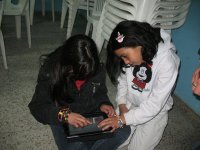Do the Right Thing: Managing the Digital Lives of Teens
A few days ago a student approached me and said he needed to talk about something, and he wanted to meet the next day at recess. I appreciated the way he reached out to me and I looked forward to the opportunity to meet with him. He came into my office with a sheepish look on his face, spoke in a quiet voice and said that he had done something he was not feeling good about. I asked him what it was, and he informed me that he had violated the technology policy by downloading some games onto his school-issued iPad, bypassing restrictions and settings.
I was curious to know what made him step forward, and he shared that he had been thinking a lot about it and, while it was fun to play the games, he knew that he had violated an agreement with the school. I was impressed with his maturity and asked him if he could help us better understand how he had bypassed the restrictions on the iPad so that we could better manage our system. We went down to the tech department where he patiently and skillfully walked one of our tech people through the steps he had taken.
I wrote to his parents to let them know what had happened and how their son had handled himself with maturity, ownership of his actions, responsibility and with a willingness to help improve the school's handling and management of school-issued iPads.
I also wanted to make sure that the lines of communication would remain open with this student so that, in the future, he would come to me for help if and when he felt he needed it.
With frequent iOS updates, keeping up with how to restrict iPad settings can be a game of whack-a-mole. Schools do the best they can, but there is no fail-safe, foolproof way to figure out every single restriction on a device, whether it's an iPad or a laptop. Instead, schools need to create a culture of conversation and partnership with students to figure out how to live with and work through the opportunities and challenges that accompany instituting one-to-one programs.
Also, schools need to partner with parents to help continue the conversation at home so that we can ensure the messages from home to school and back are consistent.
Mistakes Are Opportunities: Seize Them
Every transgression and misstep presents an opportunity for dialogue between student, school and family. The end goal is to keep this circle of communication open and ongoing through respectful interactions that foster and promote listening and understanding.
The efficacy of running one-to-one programs in schools is that, through this approach to technology education for students, teachers and families, schools are providing a laboratory of trial and error and figuring out a way to make sense of the fast-changing world of technology. It's critical that we go through this process before launching students out into the world on their own, without adult guidance and support.
The digital migration patterns of teens can be confounding to adults, who struggle to keep pace with the speed at which teens shift digital spaces, from Facebook (current patterns and data indicate teens are fleeing this space), to Google Plus to Instagram, the latest "it" space for teens.
Teens want and care about their privacy, as Microsoft researcher danah boyd has revealed. And teens want to have spaces that are their own, away from what they perceive to be the prying eyes of adults. To deal with the invasion of privacy that teens feel, they're encoding their exchanges, as boyd shared recently at the NAIS Annual Conference in Philadelphia. "Kids want to be public without being public," she explained. For adults, the question to resolve is when and when not to be present, to give teens the space to achieve privacy through visibility in "networked publics."
The opportunities for dialogue with teens about online behaviors emerge when schools engage in one-to-one programs, and the sometimes thorny situations teens find themselves in are authentic and real. If the culture of conversation is open and respectful, then important and lasting exchanges can take place between teens and adults to arrive at "win-win" solutions to digital missteps.
And teens can teach adults the "how to" steps of managing those "networked publics." Adults need to understand that teens are eager and desperate to share with their peers. Teens are even eager to share with adults when they step outside the bounds of agreements forged at school or at home. Our young people want to do the right thing, but they can easily get pulled into the migration patterns of their peers. It is the job of schools and parents, working together, to give students the courage and ability to fly away from the crowd and make the right choices. That's what the student I described at the beginning of this post did. It wasn't easy for him, but he made the right choice, and we all learned from him.
